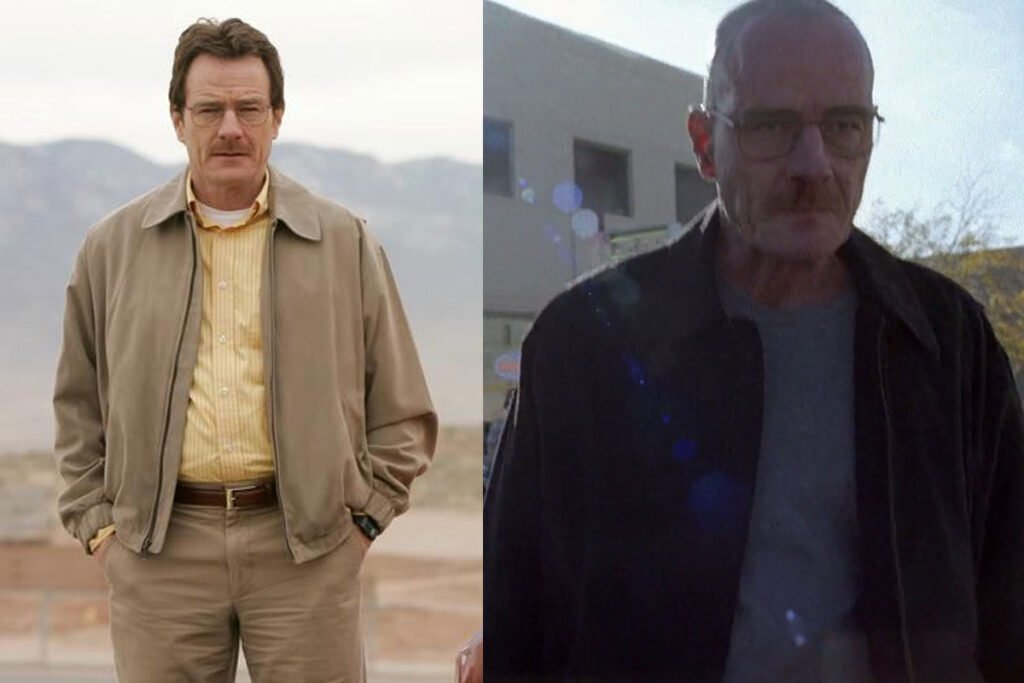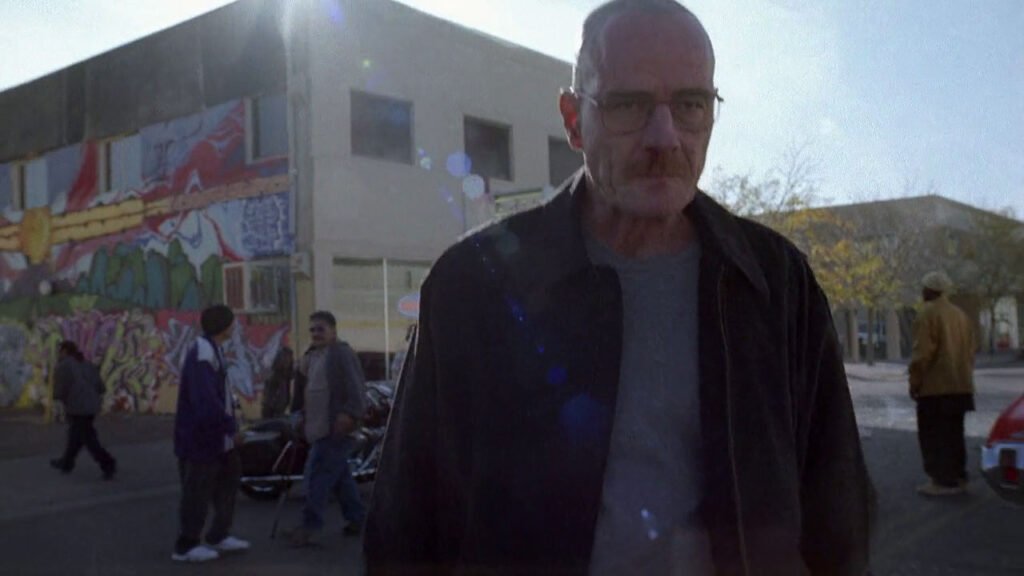Vince Gilligan’s Breaking Bad, the most talked-about show, portrays the drug dealing business most uniquely. What starts as a necessity ends up as a desire as Walter White fuses into Heisenberg. A profession he starts discreetly becomes his identity. Aiming to earn a calculated amount, he ends up with a pile of notes, no longer countable. While Walter begins to prosper in his new business, his world falls apart. This Breaking Bad review attempts to observe the torn apart world of Walter White and bring out some of the stand-out moments in the entire season.
When the fifty-year-old Walter White (Bryan Cranston), a chemistry teacher, who works at a car wash for some extra income, is diagnosed with lung cancer, guaranteeing his imminent death within a couple of years, he realises that he needs to save up money for his family. He pairs up with Jesse Pinkman (Aaron Paul) and sets up his new business. Walter’s expiry date can mean two things to him – he has limited time to provide his family with enough money for a lifetime or he has got unlimited time to do whatever his capability allows. Or it can mean both.
How mise-en-scene brings Walter’s nature to screen
Talking of the mise-en-scene in Breaking Bad, props, costumes, lighting and framing move the story ahead. Props are used as symbols to signify certain emotions of the characters. A hat is a symbol of authority, power, and autonomy. We don’t see Walter wearing the hat in any other scene except when he does his role as the dealer. The remaining eye of the pink teddy bear that has somehow restored a place in White’s home, is a reminder of the damage he has done, of his guilt because the unconscious brain knows that, though completely untraceable, it was him who has been a stubbornly inactive audience of Jane’s choking to death.
The wedding ring is visible almost all the time. It is a reminder, it is the home and when it slips off his finger it forecasts that his family, his home is gone forever. He ties the ring with a thread since he is not ready to let it go and in the next scene, he tries to get his son on call, his last attempt at getting to his family. And finally, when he makes his last gadget, the remote control gun, the ring hangs in his neck, for the last time, signifying his losses.
A cigarette is a defence for Skyler (Anna Gunn), who starts smoking when she feels helpless – when Walter White becomes secretive and when he comes to see her the last time. A cigarette is also a cover for hiding ricin. The fly, the contamination, shows things are going out of Walter’s control, his desperation, and obsession. The meth lab is where the series begins and where it ends. It is where Walter finds himself, where he is most alive, and where he dies.

Clothes are more than just adornment in Breaking Bad. They are costumes that manifest a character’s mindset; hence, in the initial episodes, Walter White wears light cloured shirts – green, yellow, beige, etc. Later, we see him more in clothes of darker shades. Also, in the last episode where he goes to see Skyler and then goes to rescue Jesse, that was when he was closer to honesty than he had been in the entire year and he wears a beige-coloured jacket.
He shaves his head off and keeps trimming them in a gap of a few days. In fiction, baldness has some connection to evilness. Here, Walter shaves his head moments before visiting Tuco and consequently blowing his office. The baldness was a mark of his transition into Heisenberg.
What Kept Him Going
As aforementioned in this Breaking Bad review, Walter’s limited time to provide for his family or his unlimited time to do whatever his capability allows or both has led him to become what he is now. But is it really time or responsibility that drives him to the meth business? Was he only thinking about his family while manufacturing the meth? In my opinion, it was the success that kept him going?
A highly efficient and hardworking man degraded to a meagre job like car washing. Imagine being underpaid all your life. Imagine that crippling feeling of being incapable of providing enough for your family. This is what Freud explains as the Return Of The Repressed. The aggression that had been piling up inside Walter’s unconscious mind was now emerging because he was dying, he had to earn for his family and because he was free to choose his actions and was succeeding in his pursuit; so much that recovering from his illness wasn’t good news.
“When I got my diagnosis, cancer, I said to myself, you know: “Why me?” And then the other day, when I got the good news, I said the same thing.”

Besides Walter’s tremendous success in the meth business, the fact that nobody can catch him is what kept him going. He can set a car alight in broad daylight, he can blow up Tuco’s office, he can beat up a bunch of boys in a shopping mall, and nobody would catch him. In fact, he clearly tells Hank (Dean Norris) that before the DEA can ever arrest him, he would be dead.
The fact that nobody can catch him does not imply that the DEA is not coming for him. Psychologically, humans are attracted to risk; it gives a strong sense of pleasure. The fear of getting caught, escaping by an inch being surrounded by risk was thrilling. After spending fifty years of chaotic free, trouble-free life and a life devoid of thrill, Walter is bound to be attracted by risk.
“I did it for me. I liked it. I was good at it. And I really … I was alive.”
Other Stand Out Moments
The cyclical narrative is interesting anyway, but when you see a teddy bear floating in the pool, the Schindler’s List effect makes it all the more cinematic, followed by men in uniform lifting corpses on stretchers from Walter’s backyard, and then you’re left with that unsettling feeling till the end of the season, it does become thrilling. The narrative, in each episode, season, and the entire Breaking Bad series, goes in circulation. The beginning of the first episode feels like the naked Walter White and unconscious Jesse are chased by the police but only at the end of the episode do we know it was a fire Bridget vehicle.
Jesse’s bouncing car dancing, a kid trapping a tarantula in a jar, or a bald Walter walking in the middle of the chaotic road with a smirk are beginnings that do not drive the narrative, are not the central part of the narrative but only an outcome, an after effect.
Last, but not least, is compositions – camera angles, framing, lighting, and so on. The scene where Skyler reminds Walter that he is not a criminal but a school teacher followed by Walter informing Skyler that he is the danger shows a shift in power through a shift in the composition of characters – from Skyler sitting up straight taking a larger space of the frame against Walter bent down to Skyler sitting on the bed and Walter hovering on her. Or, the “Stay out of my territory” scene, where Walter’s half-lit face takes up most of the frame and stays like that for a bit longer, showing his power over the other party. The fun part is where critical moments like this one or the one where nine guys in jail are killed, Walter’s working with Todd are put against old classic songs like the DLZ, Pick yourself up, Goin’ down, etc.
Conclusion
In my opinion, more than a series well started, a series well ended is important. Breaking Bad follows the set standard of narrative – status quo, threatened, fought, and after the chaos either the status quo is restored or a new stage is reached. It mainly lies in the threat and the way it is fought, the frequency and height of trouble, the strategies to deal with them that make a show interesting. That being said, equal importance lies in the newly attained equilibrium, which here is White’s death in the meth lab, the money safely escorted to the family through Schwartz, Jesse has been set free, and rest everybody is killed. Hence, ends the meth business with Heisenberg’s death.
Success paves way for more success, more money, more power. This slips in greed that plagues virtue and it takes over wisdom and, before it can be identified, marks the beginning of the end. In Breaking Bad, accepting Gus Fring’s ‘three million in three months’ offer was that turning point for Walter. It was greed for money and power that killed Hank, Mike, the nine men, and almost killed Jesse. Money and power come hand in hand but it is the source of money that decides the nature of power. What Walter wanted was to rise higher, but what he failed to realize was that he was damaging his foundation every time he committed a crime. And the trouble with Crime is that it never pays.
“Jesse, you asked me if I was in the meth business or the money business… Neither. I’m in the empire business.”


